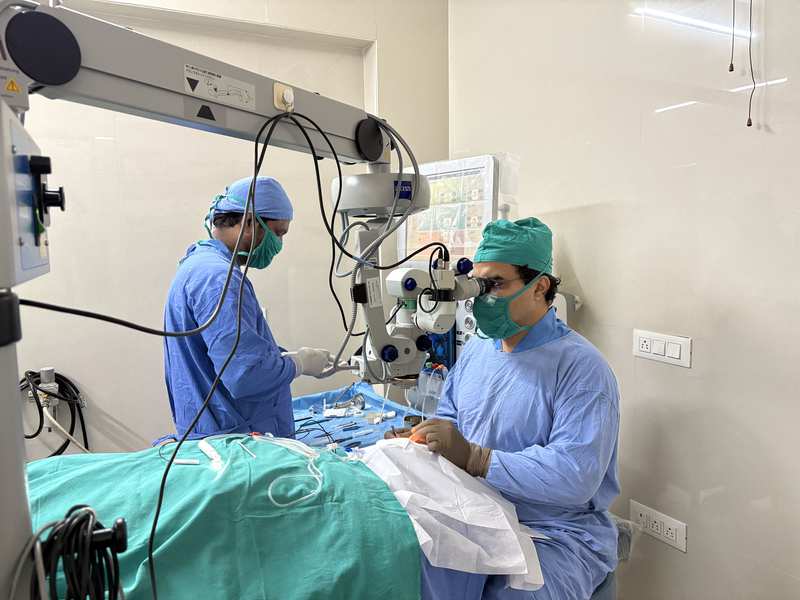Cataracts & Lens Implants
LENS IMPLANTTwenty five years ago the usual treatment for cataracts was removal of the clouded lens followed by wearing glasses with very thick lenses, while presbyopia required the use of reading glasses. Today, due to the amazing advancements in IOL technology, a patient can hope for and achieve good to excellent vision quality from a lens implant without the need for glasses at all. A lens implant or intraocular lens (IOL) is an implanted synthetic lens that replaces the eye's natural lens.Depending on the type selected, an IOL can also correct the eye's existing refractive error (nearsightedness or farsightedness) and a patient who has received an IOL can still have his or her vision further improved with laser vision correction.The type of lifestyle IOL determines the quality of vision improvement. MONOFOCAL IOLMonofocal IOLs are the 'standard' or conventional type of lifestyle IOL. By definition, a monofocal IOL provides good vision correction for one distance only. The power of the lens is pre-calculated for each individual, generally for far vision. However, some patients, with their doctor's recommendation, may choose to correct for near vision. If corrected for far vision, glasses for reading will still be needed and patients with astigmatism may still require glasses to sharpen their distance vision.MULTIFOCAL IOLMultifocal IOLs provide vision correction at all distances. Multifocal IOLs are more costly and generally not fully covered by insurance, but are frequently preferred over monofocal IOLs because they can reduce or completely eliminate the need for reading glasses.PRESBYOPIAThe surgical procedure for presbyopia is essentially the same as for cataracts and offers a permanent solution to the effects of this cause of impaired vision.The direct translation of presbyopia is "elder eye". This condition is due to the loss of flexibility of the natural lens of the eye.As a person ages beyond his or her 40s, the lens gradually becomes more rigid and the eye muscles can no longer flex enough to focus for close-up vision. In the past, presbyopia was usually addressed with bifocal lenses, reading glasses, or monovision contact lenses.Common symptoms of presbyopia are:1. Difficulty reading fine print, particularly in low light conditions2. Eyestrain when reading for long periods3. Blurred near vision4. Difficulty transitioning between viewing distances from close to far5. The feeling that your arms have become "too short" to hold reading material at a comfortable distance THE PROCEDURE More than three million cataract surgeries are performed in each year. Cataract surgery is considered one of the safest and most effective of all medical procedures.The virtually painless procedure usually takes 15-30 minutes. The surgeon makes a small incision at or near the cornea and removes the cloudy or inflexible lens. The new lens (IOL) is then inserted into its permanent position.The most advanced type of surgical procedure – and the one performed at Vatsal eye care – is called phacoemulsification, which does not require needles or stitches.With this advanced technique the affected lens is removed and replaced with an IOL. Clear vision is restored and the eye heals rapidly. More than 97% of patients who undergo phacoemulsification experience no complications at all.Patients can usually return to their normal activities the following day.Contrary to popular myth a cataract does not have to be "ripe" before it is removed.You should consider having surgery if cataracts make it hard for you to see wellenough to do the things you enjoy.Understanding cataracts What is a cataract?Some vision problems like nearsightedness, farsightedness and astigmatism affect us from birth because they are related to irregularities of the cornea. Others, like the development of cataracts, slowly creep up on us as we age.A cataract is a"clouding" of the eye's natural lens, which results in blurred or defocused vision. Cataracts are often described as looking through wax paper or cloudy cellophane. People with cataracts also have color differentiation issues and may not be able to tell the difference between two black socks. In most cases cataract surgery is required where the natural lens is replaced with a man made lens, often referred to as IOL or intraocular lens. This surgery is highly successful and has been drastically improved over the years.WHAT ARE SYMPTOMS OF CATARACT?1. Blurred or cloudy vision2. Colors appear faded or dull3. Lamps such as headlights or streetlights have glare or halos; sunlight may appear too bright4. Poor night vision5. Double or multiple vision in one eye; this effect may disappear as the cataract grows6. Frequent prescription changes in your eyeglasses or contact lensesImportant Note: These symptoms can indicate other eye problems that may also result in blindness if left untreated. If you have any of these symptoms, make an appointment with Vatsal eye care immediately for a complete eye examination. WHAT CAN I EXPECT FROM CATARACT SURGERY?Cataract surgery is almost always highly successful. Over 90% of patients who have the surgery enjoy improved vision. Many patients find that their vision improvement begins immediately and they can often resume normal activities within hours after surgery.Some find their vision better than ever after the procedure, while others may need to wear glasses for reading (known as Presbyopia) and other activities.During the initial healing period there may be a few limitations on strenuous activities, but most people can return to normal life quickly. They are surprised to find that they can also engage in activities that were once off-limits due to cataracts, such as reading and social activities. Of course, there is some risk with any surgery, and a perfect result, no matter how likely, cannot be guaranteed. Make sure you discuss the surgery in detail with us, and get all of your questions answered. At Vatsal eye care, we welcome and encourage our patients' questions. WHAT CAUSES CATARACT?Researchers believe that there are several causes:1. Aging2. Diabetes3. Long-term exposure to ultraviolet light4. Exposure to radiation5. Hypertension6. Smoking7. Alcohol abuse8. Eye injuries9. Genetic factors (a parent or grandparent who had cataracts)In the early stages of cataracts, one sees colors less vibrantly. In the later stages, the lens becomes almost opaque and has to be replaced with a clear artificial lens. This procedure is called refractive lens exchange.Currently, there are no medications, eye drops, exercises or glasses that willcause cataracts to disappear. Cataracts can only be treated surgically.THE FUTURE IS BRIGHT FOR PEOPLE WITH CATARACTS!With treatment, most can enjoy better!!
READ MORE
 +918048060722
+918048060722









